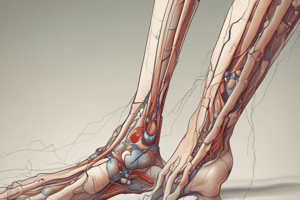Podcast
Questions and Answers
What is the primary impact of an injury to a named peripheral nerve compared to a nerve root injury?
What is the primary impact of an injury to a named peripheral nerve compared to a nerve root injury?
- Significant loss of both sensory and motor function in all cases
- Greater sensory loss with minimal motor impact
- Variable sensory and motor loss depending on the nerve involved (correct)
- Dominant motor function loss with no sensory impact
Why is activity, such as walking, important for the health of articular cartilage?
Why is activity, such as walking, important for the health of articular cartilage?
- It eliminates the need for cartilage maintenance as the activity reduces wear.
- It enables the growth of new cartilage cells constantly.
- It increases the blood supply to cartilage directly.
- It promotes the distribution of nutrients through fluid movement. (correct)
Where in the body would you typically find large motor units?
Where in the body would you typically find large motor units?
- In the hands for detailed tasks
- In the leg muscles for powerful movement (correct)
- In the eye for precise control
- In the tongue for fine motor skills
What is a dermatome?
What is a dermatome?
What types of tissues show up brightest on a radiograph?
What types of tissues show up brightest on a radiograph?
Flashcards are hidden until you start studying
Study Notes
Nerve Root vs Named Peripheral Nerve
- Nerve roots originate from the spinal cord and branch into peripheral nerves which innervate muscles and skin.
- Injury to a nerve root can cause broader issues affecting multiple nerve distributions, while injury to a named peripheral nerve usually impacts localized motor and sensory functions.
- Motor function impairment from a nerve root injury may affect multiple muscle groups; a peripheral nerve injury typically causes weakness in specific muscles related to that nerve.
- Sensory impacts from nerve root injuries can lead to pain or loss of sensation in a dermatome area; peripheral nerves produce issues in specific regions corresponding to their distribution.
Importance of Activity for Articular Cartilage Health
- Articular cartilage relies on mechanical loading during weight-bearing activities to maintain its health and nutrition, promoting chondrocyte function.
- Walking stimulates the synovial fluid movement, ensuring nutrition and waste removal for cartilage cells, critical for maintaining cartilage integrity.
Functional Advantage of Stratified Squamous Epithelium
- Stratified squamous epithelium is strategically beneficial in the epidermis as it offers protection against mechanical damage, pathogens, and water loss.
- The multiple layers provide durability and resilience, which are essential in areas subject to abrasion and injury.
Motor Unit Definition
- A motor unit consists of a motor neuron and all the muscle fibers it innervates, allowing for coordinated muscle contraction.
- Large motor units are commonly found in muscles responsible for gross motor activities (e.g., quadriceps); they enable powerful and coarse movements.
- Small motor units are typically located in muscles requiring fine motor control (e.g., intrinsic hand muscles) for precise tasks.
Dermatome Explanation
- A dermatome is a skin segment innervated by a single spinal nerve root, allowing for localized sensory and motor function assessment.
- Example: The C6 dermatome correlates with sensation in the thumb and lateral forearm; injury may result in specific sensory loss in that area.
Function of Posterior Primary Ramus (PPR)
- The PPR supplies motor innervation to the deep back muscles and provides sensory innervation to the skin overlying the back.
- It plays a role in proprioception and reflexes, crucial for maintaining posture and balance.
Characteristics of Cervical Vertebrae
- Cervical vertebrae have transverse foramina for vertebral artery passage, a unique structural feature not found in other vertebrae.
- They possess smaller, oval-shaped bodies for increased mobility, distinguishing them from thoracic and lumbar vertebrae.
Characteristics of Thoracic Vertebrae
- Thoracic vertebrae have articular facets for rib attachment, enabling the stability required for the thoracic cage.
- They feature longer spinous processes that slope downward, aiding muscle attachment and stability during movement.
Radiodensity Definition
- Radiodensity refers to the ability of tissues to absorb X-rays, impacting their appearance on radiographs.
- Denser tissues appear white/light gray on radiographs, such as bone; less dense tissues such as fat appear darker/black due to lower X-ray absorption.
Studying That Suits You
Use AI to generate personalized quizzes and flashcards to suit your learning preferences.




